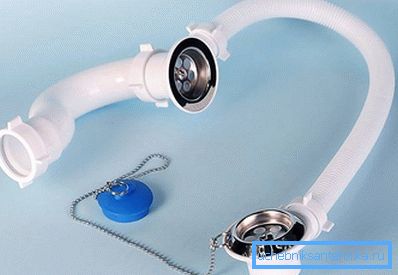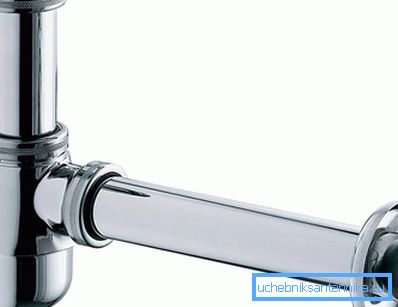Installing the siphon yourself
Siphon is a product that has a water seal. Installation of the siphon is made in the system next to the sanitary device before entering the sewer.
Where exactly are the siphons installed? This is usually the following plumbing or electrical engineering:
- Bath.
- Sink or sink.
- Washer.
Siphons are available in two types:
- semi-automatic type;
- automatic.
For Bath

These products, installed in the sewer system at the junction with the bathroom, are usually fully or partially automated. If we talk about a semi-automatic siphon, then it has a cable that connects the drain and overflow block mechanisms together with the drain plug at the bottom. To open or close the drain hole, you just need to rotate the overflow cover.
Semi-automatic siphons are distinguished by their suitable design, they are convenient to use. However, as time passes, the cable in them may start to jam. This is due to its wear, poor quality (fake) and / or mechanical stress.
Automatic bath siphon has a different principle of operation. It consists in the fact that the overflow hole mechanically controls the drain plug located outside the bath. It is very convenient when there is hot water in the bathroom that needs to be released, or there is no desire to wet your hands.
Installation

The bath usually has a pair of holes, one of which is at the bottom level, and the other is slightly higher in the front wall. This determines the design of the bath siphon. This includes the following parts:
- plastic corrugated tube (for flow in the front wall);
- plastic cup for drain installed in the bottom of the tub;
- knee with pipe that are needed to join the sewer system.
First of all, the siphon is collected on the bath. Then check how it is located under the bathroom, and whether there will be problems after its installation. It is also important before starting the plumbing work to consider how the pipes will pass, and also to calculate what the length and thickness of these pipes will be.
In the hole of the bath, located on the front wall, a metal rim is mounted, and then a branch pipe is attached to it. After that, the plum cup is bolted to the drain hole in the bottom. To connect the siphon with all the holes, you must remember the following order of work. In the round plate on the bath itself there is a metal bolt - you need to unwind it. Then, using this bolt, the branch pipe, which departs from the siphon, is screwed to the hole.
When the siphon and its components are assembled, the free end of the corrugations is connected to the sewer pipe, then all joints are checked for tightness. The test is carried out by feeding water into the bath at first under a slight pressure. Then, if there is no leak, the pressure is gradually increased. If, as a result, the water does not flow anywhere, then the siphon is properly assembled and can be used.
For sink

Choosing a siphon on the sink, you need to pay attention to its quality and whether it will match the design of the bath. Be sure to determine where it will be installed. The installation site can be completely hidden from view, slightly visible or completely open. If possible, it does not interfere with finding out in the store what material the siphon is made of.
Tip! Choosing a siphon by design, you can purchase white products coated with chrome (made of brass or plastic), as well as special designer siphons made to individual orders, taking into account the specific interior of the bathroom.
A well-established siphon of tubular type, known as a U-shaped siphon, during operation. Its distinguishing feature is that it is not as hard and not as often clogged as the bottle. This applies particularly to products made of brass, not plastic.
By their design, siphons are divided into the following types:
- corrugated;
- bottle;
- pipe.

However, such a siphon is difficult to clean from the dirt that has accumulated in it, which is its main disadvantage. For their complete removal will have to remove and disassemble the entire siphon.

Tip! It is important to ensure that during installation no gasket is damaged and threads are not torn off.
Into the pipe through which water is drained, insert the outlet and seal it. Then water is supplied, and the whole structure is checked for integrity and tightness. It is very important that there is no leak anywhere. To avoid this, you can additionally reel the thread with a towel or fluff silicone.
Pipe siphons are predominantly mounted in the sinks inside the bathrooms. They are not rational to use in the sink in the kitchen, because there they must be more often cleaned. The design of pipe siphons is compact and often attractive in design. Outwardly, this siphon looks like a pipe, which is curved so that a water seal is created in it. As a rule, the lower part is removed without problems, so that you can remove the accumulated debris.
Video
This video demonstrates how a semi-automatic bath faucet works: